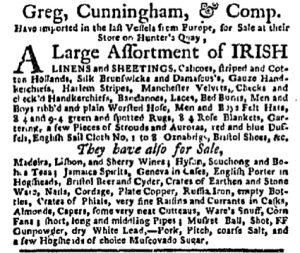GUEST CURATOR: Ceara Morse
What was advertised in a colonial American newspaper 250 years ago today?

“THE METHOD and plain PROCESS FOR MAKING POT-ASH.”
Before reading this advertisement, I had not even heard of potash. After a bit of research I found an article by William Roberts III, “American Potash Manufactured Before the American Revolution.” I discovered that potash, “the principal industrial chemical of the eighteenth century,” came from wood ashes and had many different uses, from bleaching cloth to making soaps to creating dyes.[1] Nonetheless, this industry did not become widespread in the colonies until a decade before the Revolution.
One reason that the potash industry grew in the colonies was because of the great amount of trees in North America while in England there was an “early depletion of English woodlands [that] had discouraged growth of the industry.”[2] Thomas Stephens had an part in the development of the potash industry in the colonies. Around the middle of the eighteenth centruy, he claimed “to have developed a method of making potash profitably in North America” to the Board of Trade.[3]
**********
ADDITIONAL COMMENTARY: Carl Robert Keyes
Today’s advertisement did not attempt to sell potash itself but rather Thomas Stephens’s pamphlet detailing how to produce the commodity, The Method and Plain Process for Making Pot-Ash Equal, If Not Superior to the Best Foreign Pot-Ash. As Ceara indicates, potash production and export did not become a viable enterprise in the colonies until just before the Revolution. Until that time, Britain depended primarily on Germany and the Baltic for potash. Given the competition, it makes sense that Stephens sought to assure readers and potential potash entrepreneurs that, with the guidance offered in his book, they stood to produce a profitable commodity.
Parliament was indeed interested in cultivating an American potash industry. In response to Stephens’s claim that he had developed a method that would significantly expand potash production in the colonies, Parliament promised “the sum of £3000 whenever he had done enough promoting and publicizing to satisfy the Board of Trade and the Treasury Lords.”[4] That promoting and publicizing resulted in his pamphlet, advertisements to promote the pamphlet, and perhaps even “PROOF BOTTLES belonging to this Treatise” that contained samples to verify the quality of potash made using his “METHOD and plain PROCESS.” Selling the pamphlet may have generated some revenues for printer William Weyman, but Stephens stood to benefit from a much more significant windfall once enough copies had been distributed.
According to Carl Bridenbaugh, Stephens made a tour of several southern colonies to promote his pamphlet in 1757, beginning in Charleston and visiting more than half a dozen cities and towns in the Carolinas and Virginia.[5] Stephens returned to England that same year, but a decade after his departure his pamphlet was still advertised in American newspapers. In the early 1760s, James Stewart, dispatched from London by the Society for the Encouragement of Arts, Manufacturers and Commerce, toured New England and New York. Bridenbaugh credits Stewart with being such a successful advocate that “potash became a staple commodity of New York and New England.”[6] For readers of the New-York Gazette interested in entering or improving potash production, Stephens’s pamphlet may have supplemented Stewart’s instruction.
**********
[1] William I. Roberts, III, “American Potash Manufacture before the American Revolution,” Proceedings of the American Philosophical Society 116, no. 5 (October 1972), 383.
[2] Roberts, 383.
[3] Roberts, 383.
[4] Roberts, 384.
[5] Carl Bridenbaugh, The Colonial Craftsman (Chicago: University of Chicago Press, 1950), 104.
[6] Bridenbaugh, Colonial Craftsman, 105.







